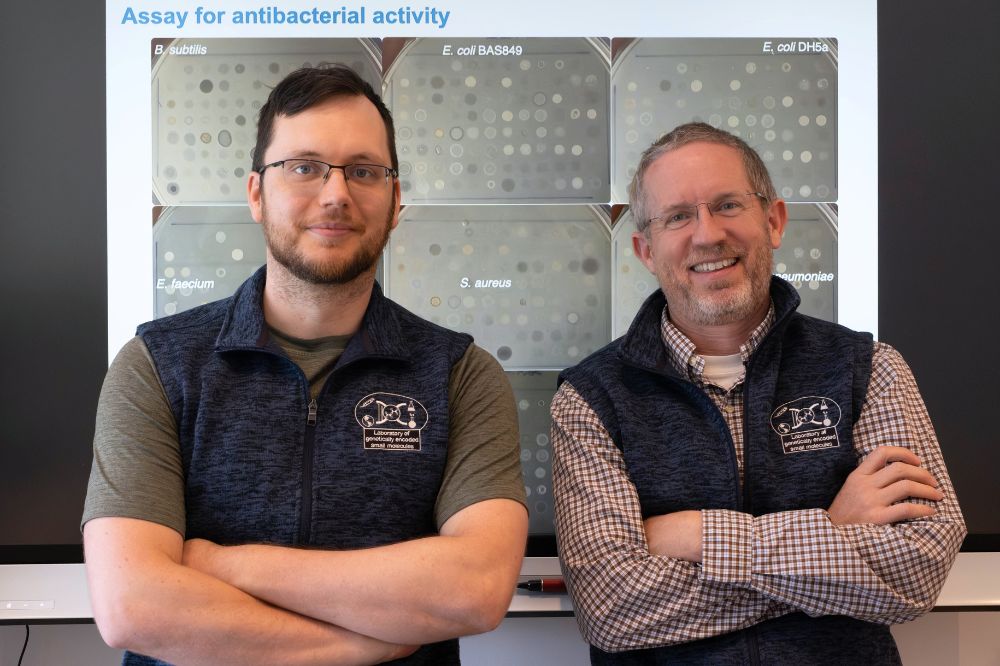
Jan Burian and Sean F. Brady devised a method to search for potential drug compounds, less prone to antibiotic resistance. (Credit: Lori Chertoff)
Bacteria have long been a key source of lifesaving antibiotics, but most species cannot be grown in the lab-leaving their therapeutic potential untapped even as multidrug resistance becomes an increasingly urgent threat. A team at Rockefeller's Laboratory of Genetically Encoded Small Molecules recently developed a workaround to that longstanding experimental stumbling block, which could breathe new life into otherwise dry antibiotic pipelines: a method for both extracting huge stretches of bacterial DNA directly from dirt and using bioinformatics to sift antibiotics candidates out of the mix. In a recent paper, they describe how this method has already uncovered hundreds of never-before-seen genomes and two promising broad-spectrum antibiotics.
The study marks a breakthrough in accessing the so-called microbial dark matter that lurks everywhere on our planet. We asked Sean F. Brady, who heads the lab, and lead author Jan Burian, how the findings may kickstart a new era of discovery in microbiology.
Your lab has been studying soil microbes for decades. Why has this been such a huge focus of your work?
Sean Brady: There's no place more familiar than soil-you played in it when you were a kid, humans have been farming it for thousands of years-yet it's still terra incognita, in many ways. All over the world there's this ecosystem of microbes, which probably have dramatic effects on our lives that we don't yet understand. Bacteria likely shape climate, agriculture, health, and biogeochemical cycles in profound ways, but there are so many species we've never been able to see, let alone study. Part of my fascination is the desire to explore the unknown. But there's also a purely practical reason: microbes have been the source of most of our antibiotics, and I wanted to overcome major obstacles to mining them for new drug leads.
Jan Burian: It's really exciting that we ended up discovering even more than that. Our lab mainly works on small molecules and discovering new antibiotics, but we know microbes also help us understand how the world works. If we can better understand the role of bacteria in the natural world better, the implications stretch beyond biotechnology and medicine.
What was preventing us from making these discoveries?
SB: The vast majority of bacteria are unculturable-that's the overall problem. Another problem is that, even if you have the DNA from bacteria that should yield an antibiotic or other interesting small molecules, that doesn't mean it's going to get expressed in the laboratory. Here I think we've provided a strong potential solution to one question that this field has been asking for 150 years: there are untold microbes out there in the world that we can't see. How do we begin to observe them?
How does your new method work?
SB: Our first big breakthrough came when Jan figured out how to extract really big DNA sequences from soil. If we can't culture the bacteria themselves, then we need to assemble their genomes somehow, and it's much simpler to do that using big DNA strands rather than stringing together little fragments. Once we had the DNA, we needed to figure out how to use it, so we used long-read sequencing to see the genomes clearly. And then we wanted to convert it all into something interesting-turn that DNA into what the bacteria might make in nature. So we used bioinformatics to predict what the genes might do, synthesize the predicted molecule, and experiment with them.
And you ended up finding antibiotics?
SB: Yes-our study is exciting because we're not just seeing new things, we're coupling what we see with an engine that can turn what we find into something potentially useful. In our paper, we highlight two antibiotic candidates, including one that was broad-spectrum, that we were able to find and synthesize, but that's just the tip of the iceberg. We've created a paradigm of how to unlock information in these genomes without ever having to culture these bugs, and we expect many more discoveries to come from that.
You also discovered several new genomes from never-before-seen microbial species.
JB: We did, and that brings up an interesting point about how discoveries in this field have evolved throughout history. When microbiology started, it was almost entirely based on microscopy. You had this huge diversity that you could then see-that's how we discovered the existence of many microbial species-but you couldn't study them. So for the next hundred years, the field shifted to culturing bacteria, primarily because people were interested in studying the germs to better understand disease. But now we've come full circle. We're back to looking at bacteria that we can't grow. Except this time we have the genomic tools to study them as well.






